#allan hills 84001
Note
I want to see meteorites
well lucky for you, i just took a whole class on planetary geology, so here's a couple of fun meteorites.
but first, a definition. meteorites are fragments of the primordial solar nebula that were not accumulated into the present planets or come from planets in our system.
widmanstatten structures are very cool and present in many meteorites and look like the photo below. they are brought out by acid etching meteorites after cutting and polishing them. they are thought to be formed in the centers of planetary and smaller bodies, and probably what the earth's core looks like.
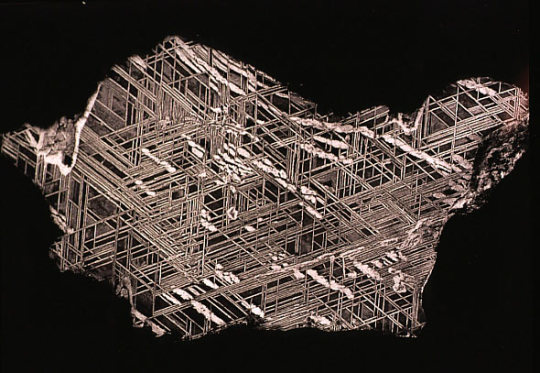
stony-iron meteorites are popular favorites for slabs because they often are a mix of, as you might guess, iron and olivines. they look like this:

among the famous meteorites is allan hills 84001, a carbonaceous meteorite found in antarctica and from mars made famous for the potential biotic (made by living creatures) structures. this one has been the subject of heated debate, but personally i'm not convinced that it's biotic.
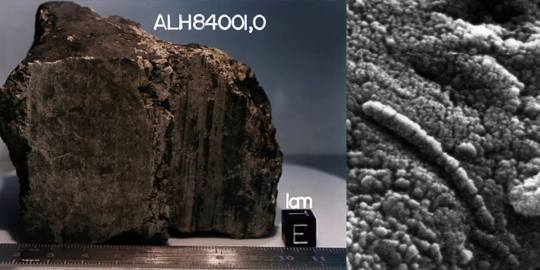
and another famous meteorite, angra dos reis. this is one of 6 meteorites classified as an angrite, a meteorite that (might be) from mercury. angrites are cool as hell and there's a lot out there about them and why they may or may not be from mercury, too much for me to discuss in this post, but i definitely recommend looking into them because they're really interesting.
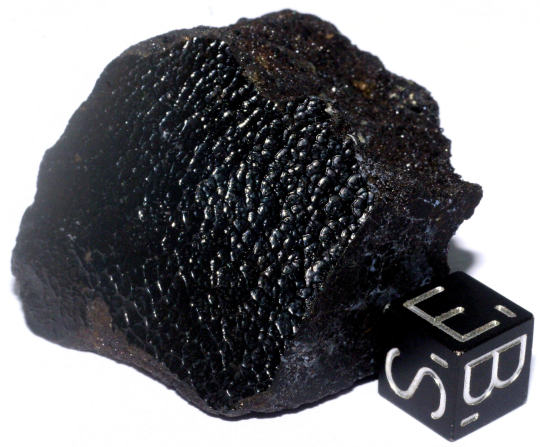
meteorites are super cool! if you want to learn more, looking into the research around the two meteorites is a good intro to how meteorite research works, the challenges that comes with studying extraterrestrial objects, and the rigorous scientific debate that occurs within the planetary geology community. enjoy!
72 notes
·
View notes
Text
Fosilele marțiene și viitorul pământului
youtube
View On WordPress
0 notes
Photo
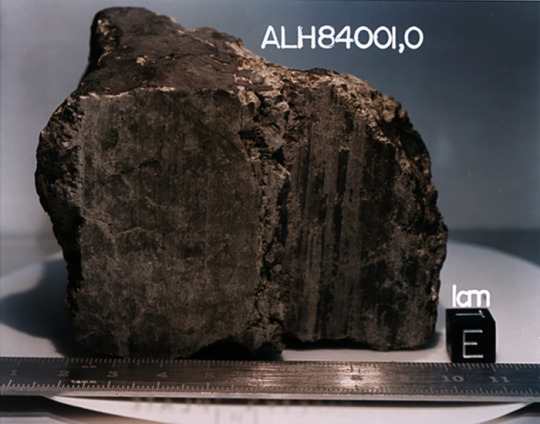
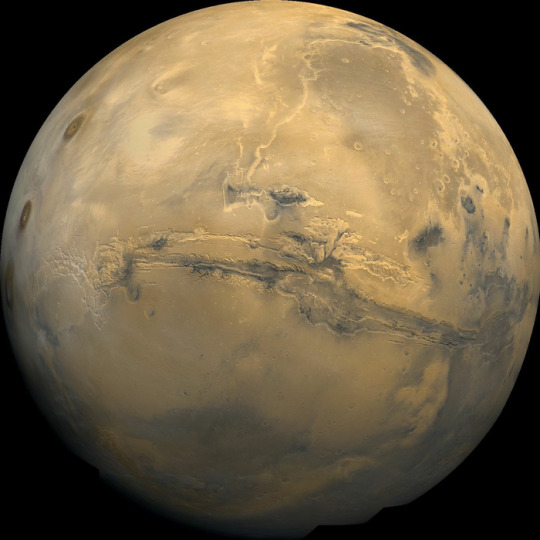
Martian meteorite’s organic materials origin not biological, formed by geochemical interactions between water and rock Organic molecules found in a meteorite that hurtled to Earth from Mars were synthesized during interactions between water and rocks that occurred on the Red Planet about 4 billion years ago, according to new analysis led by Carnegie’s Andrew Steele and published by Science. The meteorite, called Allan Hills (ALH) 84001, was discovered in the Antarctic in 1984 and is considered one of the oldest known projectiles to reach Earth from Mars. “Analyzing the origin of the meteorite’s minerals can serve as a window to reveal both the geochemical processes occurring early in Earth’s history and Mars’ potential for habitability,” explained Steele, who has done extensive research on organic material in Martian meteorites and is a member of both the Perseverance and Curiosity rovers’ science teams. Organic molecules contain carbon and hydrogen, and sometimes include oxygen, nitrogen, sulfur, and other elements. Organic compounds are commonly associated with life, although they can be created by non-biological processes as well, which are referred to as abiotic organic chemistry. For years, scientists have debated the origin story for the organic carbon found in the Allan Hills 84001 meteorite, with possibilities including various abiotic process related to volcanic activity, impact events on Mars, or hydrological exposure, as well as potentially the remnants of ancient life forms on Mars or contamination from its crash landing on Earth. The Steele-led team, which also included Carnegie’s Larry Nittler, Jianhua Wang, Pamela Conrad, Suzy Vitale, and Vincent Riggi as well as researchers from GFZ German Research Centre for Geosciences, Free University of Berlin, NASA Johnson Space Center, NASA Ames Research Center, and Rensselaer Polytechnic Institute, used a variety of sophisticated sample preparation and analysis techniques—including co-located nanoscale imaging, isotopic analysis, and spectroscopy—to reveal the origin of organic molecules in the Allan Hills 84001 meteorite. They found evidence of water-rock interactions similar to those that happen on Earth. The samples indicate that the Martian rocks experienced two important geochemical processes. One, called serpentinization, occurs when iron- or magnesium-rich igneous rocks chemically interact with circulating water, changing their mineralogy and producing hydrogen in the process. The other, called carbonization, involves interaction between rocks and slightly acidic water containing dissolved carbon dioxide and results in the formation of carbonate minerals. It is unclear whether these processes were induced by surrounding aqueous conditions simultaneously or sequentially, but the evidence indicates that the interactions between water and rocks did not occur over a prolonged period. What is evident, however, is that the reactions produced organic material from the reduction of carbon dioxide. These mineralogical features are rare in Martian meteorites, and while carbonation and serpentinization have been shown in orbital surveys of Mars and carbonation has been found in other, less-ancient, Martian meteorites, this is the first instance of these processes occurring in samples from ancient Mars. Organic molecules have been detected by Steele in other Martian meteorites and from his work with the Sample Analysis at Mars (SAM) team on the Curiosity rover, indicating that abiotic synthesis of organic molecules has been a part of Martian geochemistry for much of the planet’s history. “These kinds of non-biological, geological reactions are responsible for a pool of organic carbon compounds from which life could have evolved and represent a background signal that must be taken into consideration when searching for evidence of past life on Mars,” Steele concluded. “Furthermore, if these reactions happened on ancient Mars, they must have happened on ancient Earth, and could possibly explain the results from Saturn’s moon Enceladus as well. All that is required for this type of organic synthesis is for a brine that contains dissolved carbon dioxide to percolate through igneous rocks. The search for life on Mars is not just an attempt to answer the question ‘are we alone?’ It also relates to early Earth environments and addresses the question of ‘where did we come from?’” TOP IMAGE....The Allan Hills 84001 meteorite courtesy of NASA/JSC/Stanford University. CREDIT courtesy of NASA/JSC/Stanford University. LOWER IMAGE....Mars mosaic courtesy of NASA. CREDIT Courtesy of NASA
15 notes
·
View notes
Text
4-billion-year-old nitrogen-containing organic molecules discovered in Martian meteorites
A research team including research scientist Atsuko Kobayashi from the Earth-Life Science Institute (ELSI) at Tokyo Institute of Technology, Japan and research scientist Mizuho Koike from the Institute of Space and Astronautical Science at Japan Aerospace Exploration Agency, have found nitrogen-bearing organic material in carbonate minerals in a Martian meteorite. This organic material has most likely been preserved for 4 billion years since Mars' Noachian age. Because carbonate minerals typically precipitate from the groundwater, this finding suggests a wet and organic-rich early Mars, which could have been habitable and favourable for life to start.

For decades, scientists have tried to understand whether there are organic compounds on Mars and if so, what their source is. Although recent studies from rover-based Mars exploration have detected strong evidence for Martian organics, little is known about where they came from, how old they are, how widely distributed and preserved they may be, or what their possible relationship with biochemical activity could be.
Martian meteorites are pieces of Mars' surface that were themselves blasted into space by meteor impacts, and which ultimately landed on Earth. They provide important insights into Martian history. One meteorite in particular, named Allan Hills (ALH) 84001, named for the region in Antarctica it was found in 1984, is especially important. It contains orange-coloured carbonate minerals, which precipitated from salty liquid water on Mars' near-surface 4 billion years ago. As these minerals record Mars' early aqueous environment, many studies have tried to understand their unique chemistry and whether they might provide evidence for ancient life on Mars. However, previous analyses suffered from contamination with terrestrial material from Antarctic snow and ice, making it difficult to say how much of the organic material in the meteorite were truly Martian. In addition to carbon, nitrogen (N) is an essential element for terrestrial life and a useful tracer for planetary system evolution. However, due to previous technical limitations, nitrogen had not yet been measured in ALH84001.
This new research conducted by the joint ELSI-JAXA team used state-of-the-art analytical techniques to study the nitrogen content of the ALH84001 carbonates, and the team is now confident they have found the first solid evidence for 4-billion-year-old Martian organics containing nitrogen.
Terrestrial contamination is a serious problem for studies of extraterrestrial materials. To avoid such contamination, the team developed new techniques to prepare the samples with. For example, they used silver tape in an ELSI clean lab to pluck off the tiny carbonate grains, which are about the width of a human hair, from the host meteorite. The team then prepared these grains further to remove possible surface contaminants with a scanning electron microscope-focused ion beam instrument at JAXA. They also used a technique called Nitrogen K-edge micro X-ray Absorption Near Edge Structure (μ-XANES) spectroscopy, which allowed them to detect nitrogen present in very small amounts and to determine what chemical form that nitrogen was in. Control samples from nearby igneous minerals gave no detectable nitrogen, showing the organic molecules were only in the carbonate.
After the careful contamination checks, the team determined the detected organics were most likely truly Martian. They also determined the contribution of nitrogen in the form of nitrate, one of the strong oxidants on current Mars, was insignificant, suggesting the early Mars probably did not contain strong oxidants, and as scientists have suspected, it was less-oxidizing than it is today.
Mars' present surface is too harsh for most organics to survive. However, scientists predict that organic compounds could be preserved in near-surface settings for billions of years. This seems to be the case for the nitrogen-bearing organic compounds the team found in the ALH84001 carbonates, which appear to have been trapped in the minerals 4 billion years ago and preserved for long periods before finally being delivered to Earth.
The team agrees that there are many important open questions, such as where did these nitrogen-containing organics come from? Kobayashi explains: "There are two main possibilities: either they came from outside Mars, or they formed on Mars. Early in the Solar System's history, Mars was likely showered with significant amounts of organic matter, for example from carbon-rich meteorites, comets and dust particles. Some of them may have dissolved in the brine and been trapped inside the carbonates." The research team lead, Koike adds that alternatively, chemical reactions on early Mars may have produced the N-bearing organics on-site. Either way, they say, these findings show there was organic nitrogen on Mars before it became the red planet we know today; early Mars may have been more 'Earth-like', less oxidising, wetter, and organic-rich. Perhaps it was 'blue.'
15 notes
·
View notes
Text
On This Day in History, August 6
On This Day in History, August 6
In 1583, Spanish conquistador Gonzalo Jiménez de Quesada founded a military encampment that would become Bogotá, capital of Columbia. While it would not be officially recognized as a settlement for a few years, this date is given as the traditional founding of the city. The encampment was formed during the conquest of the Muisca, an indigenous people of the Andean Mountains.
In 1945, an…
View On WordPress
#60 Minutes#alien life#Allan Hills 84001#atomic bombings#August 6#Bogota#Columbia#Enola Gay#Harry Reasoner#Hiroshima#JFK assassination#M Night Shyamalan#On This Day in History#Signs#Spanish conquests#The Last Airbender#The Sixth Sense
0 notes
Text
Scientists discover four-billion-year-old organic compounds in Martian meteorite that smashed into Antarctica- Technology News, Firstpost
Scientists discover four-billion-year-old organic compounds in Martian meteorite that smashed into Antarctica- Technology News, Firstpost
[ad_1]
FP TrendingApr 30, 2020 17:57:37 IST
Researchers have identified four-billion-year-old nitrogen-containing organic molecules in a Martian meteorite.
As per a study published in the journal Nature Communications, the organic molecules were found in the famed Martian meteorite Allan Hills 84001, which was uncovered in Antarctica in 1984.
According to researchers, the organic materials…
View On WordPress
0 notes
Photo

A New Explanation for Organics on a Mars Rock That Fell to Earth
Numerous stories have put Martians at the forefront of science fiction, but we can thank one 4-billion-year-old rock for placing life on Mars into the realm of serious, scientific discourse. That rock is the meteorite Allan Hills 84001 (ALH84001).
When scientists found evidence of organic molecules in ALH84001, some asserted that these remnants were indications of past life on Mars. This hypothesis drew intense skepticism, with many scientists identifying the molecules as contamination from Earth. Others maintained that a portion of the molecules—the meteorite’s polycyclic aromatic hydrocarbons (PAHs)—was Martian, whereas others found similar PAHs on Earth. Many scientists argued that abiotic processes, not life itself, could easily account for PAHs and other organics in the meteorite.
Nearly 30 years after the meteorite’s discovery, ALH84001’s organic molecules still fuel scientific inquiry. A new study, led by astrobiologist Andrew Steele at the Carnegie Institution for Science, inferred the geochemical environment of early Mars and the origins of ALH84001’s organics. The research was published earlier this month in Science.
1 note
·
View note
Text
De organische moleculen in Marsmeteoriet ALH 84001 zijn niet biologisch van oorsprong
De organische moleculen in Marsmeteoriet ALH 84001 zijn niet biologisch van oorsprong
De Allan Hills 84001 meteoriet. Credit: NASA/JSC/Stanford University.
Recent onderzoek aan Allan Hills (ALH) 84001, de 1,93 kg zware meteoriet die in 1984 op de Zuidpool werd ontdekt en die afkomstig is van Mars, laat zien dat de organische moleculen die in de meteoriet zijn aangetroffen géén biologische oorsprong hebben. Andrew Steele (Carnegie Science) en z’n team hebben de meteoriet onderzocht…

View On WordPress
0 notes
Text
De organische moleculen in Marsmeteoriet ALH 84001 zijn niet biologisch van oorsprong
De organische moleculen in Marsmeteoriet ALH 84001 zijn niet biologisch van oorsprong
De Allan Hills 84001 meteoriet. Credit: NASA/JSC/Stanford University.
Recent onderzoek aan Allan Hills (ALH) 84001, de 1,93 kg zware meteoriet die in 1984 op de Zuidpool werd ontdekt en die afkomstig is van Mars, laat zien dat de organische moleculen die in de meteoriet zijn aangetroffen géén biologische oorsprong hebben. Andrew Steele (Carnegie Science) en z’n team hebben de meteoriet onderzocht…

View On WordPress
0 notes
Text
New Review of Famous Martian Meteorite Finds No Evidence of Extraordinary Life
New Review of Famous Martian Meteorite Finds No Evidence of Extraordinary Life
The Allan Hills 84001 meteorite. Picture: Doug Mills (AP)
The material buried under the Allan Hills 84001 meteorite — a piece of rock formed on Mars 4 billion years ago — is made up of water other than the Martians, according to a new study. But scientists who believe in the fossil record are uncertain.
The 4 billion-year-old fragment of Mars formed during the Great Depression of Noah, was…
View On WordPress
0 notes
Text
Geneza martiana
youtube
View On WordPress
0 notes
Photo



4-BILLION-YEAR-OLD NITROGEN-CONTAINING ORGANIC MOLECULES DISCOVERED IN MARTIAN METEORITES Using advanced techniques, scientists have detected organic compounds containing nitrogen in Martian meteorites which were ejected from Mars's surface ~15 million years ago, proving that evidence for early life can be preserved and detected today. A research team including research scientist Atsuko Kobayashi from the Earth-Life Science Institute (ELSI) at Tokyo Institute of Technology, Japan and research scientist Mizuho Koike from the Institute of Space and Astronautical Science at Japan Aerospace Exploration Agency (JAXA), have found nitrogen-bearing organic material in carbonate minerals in a Martian meteorite. This organic material has most likely been preserved for 4 billion years since Mars's Noachian age. Because carbonate minerals typically precipitate from the groundwater, this finding suggests a wet and organic-rich early Mars, which could have been habitable and favourable for life to start. For decades, scientists have tried to understand whether there are organic compounds on Mars and if so, what their source is. Although recent studies from rover-based Mars exploration have detected strong evidence for Martian organics, little is known about where they came from, how old they are, how widely distributed and preserved they may be, or what their possible relationship with biochemical activity could be. Martian meteorites are pieces of Mars's surface that were themselves blasted into space by meteor impacts, and which ultimately landed on Earth. They provide important insights into Martian history. One meteorite in particular, named Allan Hills (ALH) 84001, named for the region in Antarctica it was found in 1984, is especially important. It contains orange-coloured carbonate minerals, which precipitated from salty liquid water on Mars's near-surface 4 billion years ago. As these minerals record Mars's early aqueous environment, many studies have tried to understand their unique chemistry and whether they might provide evidence for ancient life on Mars. However, previous analyses suffered from contamination with terrestrial material from Antarctic snow and ice, making it difficult to say how much of the organic material in the meteorite were truly Martian. In addition to carbon, nitrogen (N) is an essential element for terrestrial life and a useful tracer for planetary system evolution. However, due to previous technical limitations, nitrogen had not yet been measured in ALH84001. This new research conducted by the joint ELSI-JAXA team used state-of-the-art analytical techniques to study the nitrogen content of the ALH84001 carbonates, and the team is now confident they have found the first solid evidence for 4-billion-year-old Martian organics containing nitrogen. Terrestrial contamination is a serious problem for studies of extraterrestrial materials. To avoid such contamination, the team developed new techniques to prepare the samples with. For example, they used silver tape in an ELSI clean lab to pluck off the tiny carbonate grains, which are about the width of a human hair, from the host meteorite. The team then prepared these grains further to remove possible surface contaminants with a scanning electron microscope-focused ion beam instrument at JAXA. They also used a technique called Nitrogen K-edge micro X-ray Absorption Near Edge Structure (µ-XANES) spectroscopy, which allowed them to detect nitrogen present in very small amounts and to determine what chemical form that nitrogen was in. Control samples from nearby igneous minerals gave no detectable nitrogen, showing the organic molecules were only in the carbonate. After the careful contamination checks, the team determined the detected organics were most likely truly Martian. They also determined the contribution of nitrogen in the form of nitrate, one of the strong oxidants on current Mars, was insignificant, suggesting the early Mars probably did not contain strong oxidants, and as scientists have suspected, it was less-oxidizing than it is today. Mars's present surface is too harsh for most organics to survive. However, scientists predict that organic compounds could be preserved in near-surface settings for billions of years. This seems to be the case for the nitrogen-bearing organic compounds the team found in the ALH84001 carbonates, which appear to have been trapped in the minerals 4 billion years ago and preserved for long periods before finally being delivered to Earth. The team agrees that there are many important open questions, such as where did these nitrogen-containing organics come from? Kobayashi explains, "There are two main possibilities: either they came from outside Mars, or they formed on Mars. Early in the Solar System's history, Mars was likely showered with significant amounts of organic matter, for example from carbon-rich meteorites, comets and dust particles. Some of them may have dissolved in the brine and been trapped inside the carbonates." The research team lead, Koike adds that alternatively, chemical reactions on early Mars may have produced the N-bearing organics on-site. Either way, they say, these findings show there was organic nitrogen on Mars before it became the red planet we know today; early Mars may have been more "Earth-like", less oxidising, wetter, and organic-rich. Perhaps it was "blue." TOP IMAGE....A rock fragment of Martian meteorite ALH 84001 (left). An enlarged area (right) shows the orange-coloured carbonate grains on the host orthopyroxene rock. Credit: Koike et al. (2020) Nature Communications. CENTRE IMAGE....Carbonates plucked from ALH 84001 on the silver tape (left) and their nitrogen XANES spectra with reference compounds (right). Blue colour bar indicates the absorption energy of N-bearing organics. Credit: Koike et al. (2020) Nature Communications LOWER IMAGE....Schematic images of early (4 billion years ago) and present Mars. The ancient N-bearing organics were trapped and preserved in the carbonates over a long period of time. Credit: Koike et al. (2020) Nature Communications
4 notes
·
View notes
Text
ᴍᴇᴛᴇᴏʀɪᴛᴇꜱ
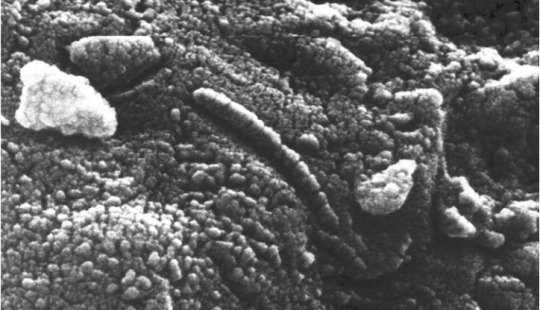
This image is a close-up of meteorite Allan Hills 84001. The electron microscope shows chain-like structures which resemble some bacteria on Earth, only much smaller. However, scientists have found that similar shapes can be formed by inorganic processes on Mars.
In 1996 a group of NASA scientists reported finding tiny 'nano-worms' made of magnetite that they believed to be evidence of tiny bacteria on Mars. The claim was largely rejected by the scientific community on the basis that the forms could have been formed by geological or analytical processes.
The rare specimen, a section of which is kept at the Museum, is much older than the majority of meteorites recovered to date and continues to be closely studied.
╭━━━━━━━━━━━━━━━╮
ᴍᴇᴛᴇᴏʀɪᴛᴏꜱ
╰━━━━━━━━━━━━━━━╯
En 1996, un grupo de científicos de la NASA informó haber encontrado diminutos 'nano-gusanos' hechos de magnetita que creían que eran evidencia de pequeñas bacterias en Marte. La afirmación fue rechazada en gran medida por la comunidad científica sobre la base de que las formas podrían haberse formado mediante procesos geológicos o analíticos.
El raro espécimen, una parte del cual se conserva en el Museo, es mucho más antiguo que la mayoría de los meteoritos recuperados hasta la fecha y sigue siendo estudiado de cerca.
┊ ┊ ┊ ┊ ┊ ┊✧°•
┊ ┊ ┊ ┊ ✧。˚ ✦¤
┊ ┊ ┊ ✫•○
┊ ┊ ✦°•
┊✦° ┊
✧ °¤ ┊ . ˚
˚✩•
0 notes
Text
Mars rocks could sustain life with underground water
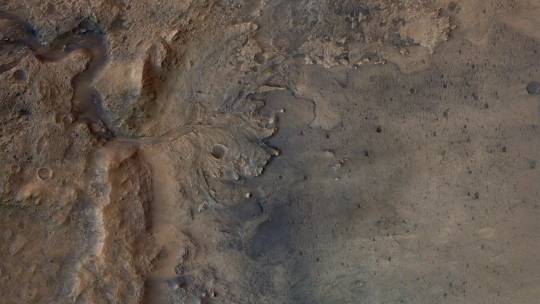

Living microbes could be hanging out beneath the Martian surface, according to a new study of Mars rocks from Brown University. The research shows that Mars could provide a stable, nourishing environment there for billions of years.
All life needs energy to survive. The life on Earth’s surface mostly gets that energy from the sun, but microbes can survive without light if they get their energy elsewhere.
“To have sufficient chemical energy for life, you need both reducing compounds and oxidizing compounds,” says Jesse Tarnas, a planetary scientist at NASA’s Jet Propulsion Lab. He led the study while completing his Ph.D. at Brown University. Reduction is just a chemical process that gives a molecule more electrons, and oxidation is one that takes them away. Microbes would need these basic chemical fuel types, along with liquid water, to survive.
The surface of Mars is barren, heavily radiated, and cold. But underground, deep enough down, scientists think the warmth of the planet’s core keeps water liquid.
Where this underground water touches Martian rocks, certain chemical reactions can take place, producing the reduction and oxidation chemicals essential for life. The chemicals form because Mars rocks, like those on Earth, typically have small amounts of radionuclides—atoms that are unstable and eventually release radiation—trapped inside them. But this radiation isn’t as overpowering as that on the surface, which kills pretty much everything.
When these nuclides emit radiation, it breaks up nearby water molecules into hydrogen gas and oxides, both highly reactive chemicals which go on to create other chemicals that can sustain life.
Testing the ingredients for life on Mars
The team used data from Martian meteorites gathered across the globe—including the famous Allan Hills 84001 meteorite—to figure out how much of these crucial chemicals could form on the red planet. They looked at the composition of the Mars rocks and calculated the amount of reducing and oxidizing chemicals those rocks could produce over time, then compared this to the rates that Earth microbes would chomp them up.
They found that some types of Mars rocks could support life’s requirements long-term. The researchers then estimated how many microbes could survive in different rocky areas under Mars, assuming that these microbes would be similar to those deep underground or on the seafloor on Earth, which feed off of sulfates instead of oxygen.
[Related: Was there ever life on Mars? Perseverance’s SHERLOC laser sniffs for microscopic clues]
This study addresses two really important factors in the habitability of another planet, says Allan Treiman, a planetary geologist at the Lunar and Planetary Institute of the Universities Space Research Association, who was not involved in the study. First, he says, “the source of energy, and second, the consistency of environments,” or how stable they are.
Though we haven’t found liquid water on Mars directly, he says, “it’s a pretty good guess that there is a lot of liquid water down there.”
This water most likely exists in pockets, Tarnas says. “Fresh” water would be several kilometers down—quite a long way to drill. But salt water pockets, like road salts here on Earth, freeze at lower temperatures, and could exist just a few hundred meters down.
This water, along with the small amount of radiation coming off Mars rocks, could supply a steady stream of the chemical energy life needs for billions of years, the researchers found. “If life did ever arise on Mars, and if groundwater is still present there,” Tarnas says—which he admits are two big ifs—“then it’s possible that habitable environment could have been a refuge for [life] from billions of years ago, all the way up to today.”
‘Nature’s drill’ on Mars could be another route to finding life
It may still be a while before rovers or astronauts dig that deep, but with technologies like transient electromagnetic sounding, Tarnas says, researchers can get an idea of where and how much water is hiding beneath the surface.
And there’s another way to glimpse the deep down of Mars.
“Nature gives us a pretty good drill, which are impact craters,” Treiman says. Large impacts on the surface of Mars have ejected rocks from deep down under the surface. “The bigger the crater, the further down you can get.”
Mars rovers like Perseverance could find and study these impact-ejected rocks to learn what Mars is like down below. Exposed on the surface, the rocks wouldn’t still have living microbes on them. But they could have microfossils, organic molecules, or signs of contact with water.
Treiman says his gut feeling all along has been that there isn’t life on Mars. “But I may have to reevaluate that,” he says. “Based on this paper, it was pretty convincing.”
New post published on: https://livescience.tech/2021/04/30/mars-rocks-could-sustain-life-with-underground-water/
0 notes
Text
㎥네가 먼저 날 차버리면 안 될까 S 운석㎮
네가 먼저 날 차버리면 안 될까 - 모노패스(Monopath) 좋아했던 너의 미소 이제 예쁘지 않아 오늘은 널 매몰차게 뻥 차버리고 싶어 바보처럼 착한 네가 이제 지겨워졌어 울고불고 매달려도 흔들리지 않겠어 어떡하니 어떡할까 말하기가 너무 미안해 어떡하니 어떡할까 미안해서 네가 먼저 날 차버리면 안 될까 그래야 덜 미안해 마음이 편하겠어 날 아직 사랑은 하니 그럼 그렇게 해줘 나를 위해서 맛있었던 너의 음식 이제는 맛이 없어 상처 없는 이별 따위 있을 리가 없잖아 어떡하니 어떡할까 말하기가 너무 미안해 어떡하니 어떡할까 미안해서 네가 먼저 날 차버리면 안 될까 그래야 덜 미안해 마음이 편하겠어 날 아직 사랑은 하니 그럼 그렇게 해줘 나를 위해서 네가 먼저 날 차버리면 안 될까 그래야 덜 미안해 마음이 편하겠어 날 아직 사랑은 하니 그럼 그렇게 해줘 나를 위해서 운석 운석 (Meteorite)은 혜성, 소행성 또는 유성체와 같은 물체에서 떨어져 나온 고체 파편들 중, 대기에서 소멸하지 않고 지구 또는 달 표면에 도달할 때까지 살아남은 물질의 총칭이다. 우주에서 유래한 물질이 지구상에 떨어지는 운동을 하고 있을 때를 유성이라 한다. 즉, 운석은 유성이 대기권을 돌파하면서 소멸하지 않고 지구상으로 떨어져 남은 것을 이른다. 그림 1. 운석 (출처) 운석은 구성 물질에 따라 크게 세 종류로 분류된다. 첫 번째로 석질 운석은 주로 규소 광물로 이루어진 운석으로, 전체 운석의 93%를 차지한다. 두 번째로 철질 운석은 주로 철과 니켈로 구성된 운석으로 전체 운석의 5%를 차지한다. 철질 운석은 밀도가 높고 열에 강하여서 지구상에 충돌 시 다른 운석보다 더 큰 피해를 일으킨다. 마지막으로 석철질 운석은 60%의 철과 다른 석질 물질로 이루어진 운석으로 전체 운석 중 1.5%로 매우 적은 비율을 차지한다. 크기에 따른 분류도 있는데 2mm보다 작은 운석은 미세 운석으로 분류된다.다른 분류로는 성인에 의한 분류가 있다. 성인에 따라서는 크게 시원운석 (또는 미분화운석)과 분화 운석으로 구분된다. 시원운석은 태양계 성운에서 집적된 물질들이 운석의 모체를 형성한 후 화성활동을 하지 않은 운석을 통틀어 이른다. 분화 운석은 이와 반대로 화성활동을 경험한 운석들을 일컫는데 화성활동을 경험하면 원래의 화학조성과는 다른 암석이 된다.운석이 지구상에서 발견되면 발견 된 장소의 이름이 붙여지며 일반적으로 인근 마을이나 지형물의 이름이 사용된다. 많은 운석이 한 곳에서 발견 된 경우 이름 뒤에 번호나 문자 (예시) Allan Hills 84001 또는 Dimmitt (b))를 붙여 표시한다. 그림 2. 호바운석 (출처) 현재 지구상에 존재하는 가장 큰 운석은 그림 2에 나타난 호바 운석이다. 이 운석은 나미비아에 위치하고 있고 80000년 전에 떨어진 것으로 추정되고 있으며 크기는 2.7 × 2.7 × 0.9 m이다. 1920년 발견되었을 당시 무게는 66톤으로 추정되었으나 현재 남아있는 무게는 60톤으로 추정된다. 이 운석은 84%의 철과 16%의 니켈로 이루어진 철질 운석이다. 그림 3. Barringer Meteor crater (출처) 이렇게 운석이 떨어지면 그 충돌에너지로 인하여 지표면에 그림 3에 보이는 바와 같이 접시 모양으로 파인 구조가 형성되게 되는데 이를 충돌구라고 한다. 그림 3은 미국 애리조나주의 Barringer 충돌구이다. 일반적으로 충동구의 직경은 화구 직경의 20~50배이고 현재 지구 표면에는 약 2백 여 개의 충돌구가 발견되었다. 지구에 운석이 충돌해도 풍화작용과 지질 활동에 의해 그 흔적이 사라지기 때문에 현재 남아있는 충돌구는 대부분 최근에 형성된 것이다. 그러나 일반적으로 충돌구에서는 운석이 잘 발견되지 않는데 이는 출동구를 형성할 정도로 강한 충돌을 할 경우 운석이 거의 증발되기 충분한 에너지가 발생되기 때문이다. 그러므로 충돌구가 형성될 경우 운석은 아주 작은 크기로 부서지게 되므로 운석이 드물게 발견된 경우에는 충돌구 주변에서 아주 작은 파편으로 발견된다.운석은 과학기술정보통진부 관할로 우주개발 진흥법에 따라 매우 철저하게 관리되고 있으며, 국내에서 발견된 운석은 국외로 반출할 수 없다. 현재 운석의 등록에 관한 사항은 한국지질자원연구원에 위탁되어 있으며 운석의 등록에 관한 법들도 우주개발 진흥법으로 제정되어있다.
0 notes
Text
Molecole organiche contenenti azoto, vecchie di 4 miliardi di anni, scoperte nei meteoriti marziani
Molecole organiche contenenti azoto, vecchie di 4 miliardi di anni, scoperte nei meteoriti marziani

A sinistra, un frammento del meteorite marziano Allan Hills 84001. Adestra, un ingrandimento del riquadro presente nell’immagine a sinistra. Mostra i grani carbonatici analizzati nello studio.
Un team di scienziati guidati da Mizuho Koike della Jaxa, l’agenzia spaziale giapponese, ha trovato composti organici contenenti azoto in minerali carbonatici presenti all’interno di Hallan Hills, una…
View On WordPress
0 notes